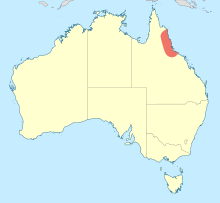Podopteryx selysi
Podopteryx selysi is a species of Australian damselfly in the family Megapodagrionidae,[3] commonly known as a treehole flatwing.[4] It can be found in coastal northern Australia and New Guinea, where its larvae live in water-filled holes in tree trunks in rainforest.[5]
| Treehole flatwing | |
|---|---|
.jpg) | |
| Australian Museum specimen | |
| Scientific classification | |
| Kingdom: | Animalia |
| Phylum: | Arthropoda |
| Class: | Insecta |
| Order: | Odonata |
| Suborder: | Zygoptera |
| Family: | Megapodagrionidae |
| Genus: | Podopteryx |
| Species: | P. selysi |
| Binomial name | |
| Podopteryx selysi | |
 | |
Podopteryx selysi is a very large damselfly, black-metallic in colour with white to pink markings on its head and body.[4] Like other members of the family Megapodagrionidae, it rests with its wings outspread.[6]
Unusually, and possibly uniquely for a damselfly, the hindwings of Podopteryx selysi are longer than its forewings. For other damselflies, forewings are usually marginally longer than hindwings.
Gallery
.jpg) Tip of female tail. Note the egg still in her ovipositor.
Tip of female tail. Note the egg still in her ovipositor..jpg) Tip of male tail
Tip of male tail.jpg) Female wings
Female wings.jpg) Male wings
Male wings
gollark: The main reason I like caddy is just that it does HTTPS conveniently, and I reshuffle subdomains and such a lot so that's quite helpful.
gollark: Apache uses some weird XMLy thing and also htaccess.
gollark: To be honest I'm kind of tempted to switch back to nginx, but its configuration is *also* somewhat annoying.
gollark: So I finished upgrading to caddy 2, and it hasn't resolved the websocket issue, irritatingly. I'm going to have to do more debugging on this tomorrow, because I can't really be bothered to do much more today after attempting to wrangle its somewhat annoying new config format.
gollark: This is a HTTPS server, so I need wireshark's TLS decryption feature.
See also
References
| Wikimedia Commons has media related to Podopteryx selysi. |
- Dow, R.A. (2017). "Podopteryx selysi". IUCN Red List of Threatened Species. 2017: e.T87532918A87534046. doi:10.2305/IUCN.UK.2017-1.RLTS.T87532918A87534046.en.
- Förster, G. (1899). "Contributions à la faune odonatologique Indo-Australe". Annales de la Société Entomologique de Belgique (Comptes-rendus) (in French). 43: 63–72 [70].
- "Species Podopteryx selysi (Förster, 1899)". Australian Faunal Directory. Australian Biological Resources Study. 2012. Retrieved 14 April 2017.
- Theischinger, Günther; Hawking, John (2006). The Complete Field Guide to Dragonflies of Australia. Collingwood, Victoria, Australia: CSIRO Publishing. p. 58. ISBN 978 0 64309 073 6.
- Theischinger, Gunther; Endersby, Ian (2009). Identification Guide to the Australian Odonata (PDF). Department of Environment, Climate Change and Water NSW. p. 233. ISBN 978 1 74232 475 3.
- Watson, J.A.L.; Theischinger, G.; Abbey, H.M. (1991). The Australian Dragonflies: A Guide to the Identification, Distributions and Habitats of Australian Odonata. Melbourne: CSIRO. ISBN 0643051368.
This article is issued from Wikipedia. The text is licensed under Creative Commons - Attribution - Sharealike. Additional terms may apply for the media files.
